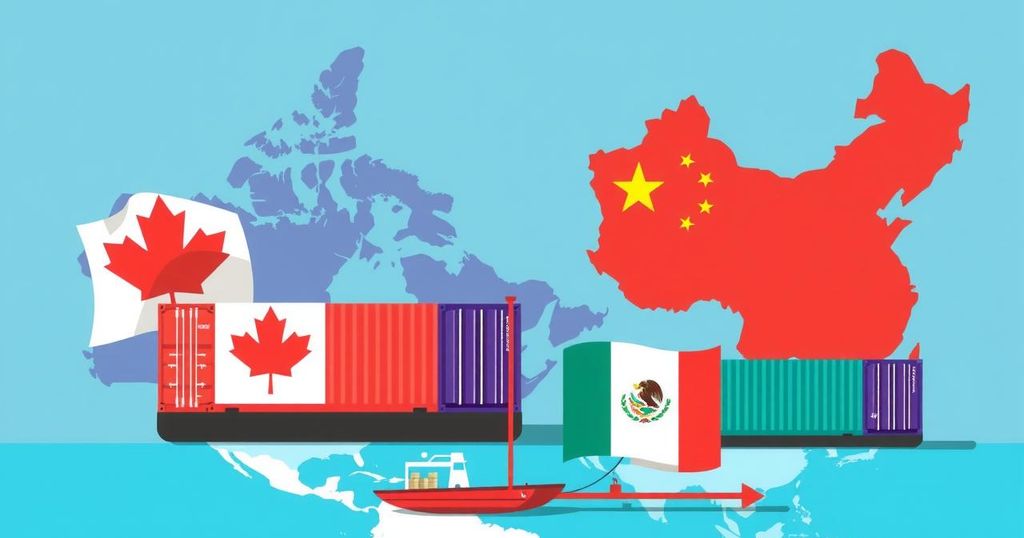President Trump has implemented sweeping tariffs on Canada, Mexico, and China, potentially destabilizing the U.S. economy and straining diplomatic relations. His varied justifications have left business leaders and economists concerned about the economic impact, including retaliatory tariffs from affected countries. As market reactions unfold, the long-term consequences for U.S. trade and household economy remain to be seen, with significant implications for various sectors.
President Donald Trump has taken a significant risk by implementing extensive tariffs on imports from Canada, Mexico, and China, causing economic uncertainties and straining relations with major trading partners. His rationale, which remains vague to many, mixes various reasons including a desire to curb drug trafficking and to repatriate U.S. manufacturing. The tariffs have triggered retaliatory measures, upsetting investors and businesses alike, raising concerns about their implications for the U.S. economy.
Canadian Prime Minister Justin Trudeau expressed confusion over Trump’s motives, suggesting his intent may be to ruin the Canadian economy in pursuit of annexation. Trudeau affirmed that Canada would resist becoming the 51st state, insisting that the tariffs would ultimately harm both countries. In response, Canada has introduced retaliatory tariffs on $30 billion worth of U.S. goods, foreseeing inevitable repercussions for American families due to the escalation.
The reactions on Wall Street were immediate, seeing a decline in stock markets globally, with sectors like finance and technology suffering the most. The S&P 500 index fell sharply amidst fears that the tariffs would destabilize the economy, particularly with inflation being a significant concern. Economists warn that this imposition of tariffs might put pressure on economic growth and family budgets, potentially causing an increase of up to $1,000 annually in household expenses.
U.S. businesses are scrambling to devise strategies for the new tariffs which include a 25% levy on products from Canada and Mexico, as well as an additional 10% on imports from China. Companies like Target have warned that rising costs may lead to price hikes for consumers, while executives express concern about the uncertainty impacting overall consumer spending.
Recent analyses predict that prolonged tariffs could reduce economic growth by a percentage point, equating to conservative growth figures of just 1% for 2025 as opposed to higher projections previously. While some unions have welcomed the tariffs as a means to protect domestic jobs, many fear that the broader economic fallout will outweigh any benefits.
Trump maintained his stance, asserting that companies could circumvent tariffs by relocating operations to the U.S. His administration’s justification was further complicated by comments from aides claiming that tariffs were a necessary tool to combat drug trafficking, despite evidence of declining drug-related deaths and border crossings.
Both Canadian and Mexican leaders have challenged the rationale behind the tariffs, asserting that the arguments presented were unfounded while emphasizing their own efforts to combat drug trafficking. With Canada and Mexico being significantly reliant on trade with the U.S., potential retaliatory actions could exacerbate the situation, impacting wide-ranging sectors including agriculture and retail.
This situation raises the question of how global trade dynamics will shift as countries seek new partnerships in response to U.S. tariffs. The Peterson Institute for International Economics indicated that reciprocal tariffs could lead to contraction in the U.S. economy, although the effects would be felt more acutely in Canada and Mexico.
The imposition of tariffs has sparked a bipartisan debate in Congress, with Republican leaders attempting to justify the actions while Democrats express condemnation. As the economic landscape continues to evolve in light of these tariffs, stakeholders remain vigilant about the long-term ramifications, both domestically and internationally.
In summation, President Trump’s recent imposition of tariffs on Canada, Mexico, and China represents a significant economic gamble with uncertain outcomes. The tariffs have prompted widespread concern about their potential impacts on the U.S. economy, market stability, and international relations. As retaliatory measures unfold, the interplay between trade dynamics, economic growth, and consumer costs will likely define the landscape moving forward. Stakeholders must navigate these complexities with an acute awareness of the evolving economic environment and the corresponding implications for both domestic and global interests.
Original Source: www.nytimes.com




